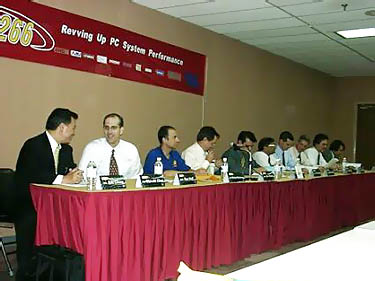Van Smith van Tom's Hardware Guide heeft een verslag gepost van de eerste Computex dag. Tijdens deze dag gaven de geheugenfabrikanten middels het organiseren van een gezamenlijke DDR sessie blijk van hun saamhorigenheid ten aanzien van de DDR SDRAM standaard. Onder andere AMD, VIA en Transmeta besproken toekomstige DDR produkten. Hyundai benadrukte het voordeel van DDR in server systemen het liet weten dat er voor DDR in 2001 een groei naar 9,1GB/s bandbreedte wordt verwacht:
The Hyundai representative, Farhad Tabrizi, mentioned that DDR SDRAM is preferable over Rambus RDRAM particularly in servers, partially due to reliability issues. DDR SDRAM is more scalable (current RDRAM offerings are very limited by the number of RIMM slots), and is also more robust in that it can survive "chip kill", a condition where a single device fails, something that RDRAM, due to its serial nature, is vulnerable to. Mr. Tabrizi projected DDR SDRAM bandwidth at 9.6 GB/s in 2001. Stating that it is a matter of pride for Hyundai, an enormous memory manufacturer, that the company is hitting its highest yields per wafer on DDR SDRAM.Partially due to DDR SDRAM's greatly reduced capacitance, DDR SDRAM consumes around half the power of SDRAM, Mr. Gervasi of Transmeta claimed. This is extremely important to Transmeta as its products are targeted to exploit the portable market where low power consumption is critical. [break] DRAM bakker Micron maakte duidelijk dat de produktiekosten van DDR chips nauwelijks hoger zijn dan die van normale SDR chips. De prijs van DDR SDRAM chips zou slechts 3% hoger zijn: [/break] Mike Seibert from Micron projected an initial 3% price premium for DDR SDRAM modules over SDRAM. In 2001 he predicted a price of $10.15 for an 8Mx16 128 Mb SDRAM ASP and $10.45 for a similar DDR SDRAM device. Mr. Siebert said that the largest expense will be on the motherboard, totaling about $6 mainly for the 2.5V voltage converter.
 |
Thanks Coen Rijkaart voor de tip.

